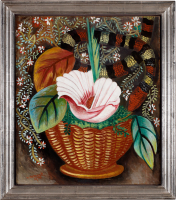Known as the ‘Queen of Bohemia’, Nina Hamnett was a powerful proponent of the British avant-garde. In the early twentieth century, she was taken under the wing of the Bloomsbury group and started her career working at the Omega Workshops for Roger Fry. Brimming with energy and colour, this still life epitomises Hamnett’s lifelong dedication to fusing art and design through a mélange of modernist language.
This strikingly surreal still life depicts a snake descending upon a basket of foliage, framed by a climbing vine of floral blooms. The blossoming pink flower in the centre of the composition is subtly evocative of the monumental flowers of Georgia O’Keefe and exudes an eroticism befitting a Bloomsbury artist. Hamnett’s introduction to the professional art world came primarily through the Omega Workshops, run by the Bloomsbury champion Roger Fry, assisted by the artists Vanessa Bell and Duncan Grant. Roger Fry employed her to work for the Omega Workshops which position that enabled her...
Known as the ‘Queen of Bohemia’, Nina Hamnett was a powerful proponent of the British avant-garde. In the early twentieth century, she was taken under the wing of the Bloomsbury group and started her career working at the Omega Workshops for Roger Fry. Brimming with energy and colour, this still life epitomises Hamnett’s lifelong dedication to fusing art and design through a mélange of modernist language.
This strikingly surreal still life depicts a snake descending upon a basket of foliage, framed by a climbing vine of floral blooms. The blossoming pink flower in the centre of the composition is subtly evocative of the monumental flowers of Georgia O’Keefe and exudes an eroticism befitting a Bloomsbury artist. Hamnett’s introduction to the professional art world came primarily through the Omega Workshops, run by the Bloomsbury champion Roger Fry, assisted by the artists Vanessa Bell and Duncan Grant. Roger Fry employed her to work for the Omega Workshops which position that enabled her to earn a steady income. Although she worked there between 1913 and 1919, Hamnett never fully shared the Omega Workshop’s affiliation with domesticity. As Judy Collins and Oriana Baddeley note in Five Woman Painters:
Nina Hamnett lived her life in a way associated with a 'masculine' form of independence; she had very few family ties, she was not dependent on anybody and nobody was dependent on her, she had no interest in home-making, cooking, and other domestic skills. She liked the social and communal aspects of pub life, she had a wide range of acquaintances rather than a few close friends, and she was quite capable of launching herself into strange company and making herself accepted.[1]
By the 1950s, Hamnett was as famed for her wild social life as she was an artist. The success of her 1932 autobiography The Laughing Torso chronicled her extraordinary life in dazzling detail and became a bestseller in the UK and the US. It detailed her love of all arts, music, theatre, literature, and her travels between Paris and London on the hunt for those at the forefront of the avant-garde. The onset of the Second World War in 1939 restricted her travel, and she turned her attention to the bohemian life offered in Soho, London.
This work was painted in the midst of her total immersion in Soho’s bohemian life. Many of her friends commiserated at her lack of artistic drive during this period of her life, although she did continue to paint and exhibit. In 1950, her work was exhibited at the Leicester Galleries’ ‘Artists of Fame and of Promise’ exhibition alongside the likes of S. J. Peploe, Duncan Grant and William Roberts. Her legacy as an equally talented and flamboyant artist endures and her work is now held in collections such as National Portrait Gallery, London, Tate, London, Charleston Farmhouse, East Sussex.
[1] Judith Collins and Oriana Baddeley, (1989) Five Women Painters. London: Queen Anne Press, p. 58.











